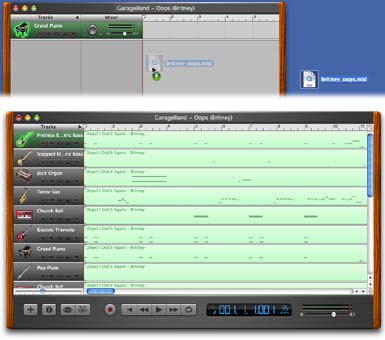9.3. Importing MIDI Files
| < Day Day Up > |
| Graphics programs can exchange documents in the form of JPEG files. Word processors can exchange text files. Web-design programs can swap HTML documents. And in the musical world, the common exchange format for finished musical masterpieces is the MIDI file. As noted earlier in this book, it's pronounced "middy," it stands for Musical Instrument Digital Interface, and it's a compact little file that contains no sound data ”just note-trigger data that relies on a computer or synthesizer to give it a voice. Hundreds of thousands of MIDI files are all over the Internet, just waiting for you to download. Just go to Google.com, type in MIDI files "76 Trombones " or whatever, and in a matter of seconds you've got a list of instrumental versions of that song, arranged and prepared by amateur or professional musicians , ready to download. Tip: When you click a link to a MIDI file on a Web page, it generally begins to play. Your screen goes blank except for a stray QuickTime scroll bar. That's not really the same as downloading the file.In that situation, hit your browser's Back button. This time, Option-click the original link. (Alternatively, Control-click the link and choose from the shortcut menu, "Download Link As" or "Save Link to Disk.") This time, instead of playing the MIDI file, your browser downloads it to your desktop. The beauty of downloading MIDI files (apart from their being free) is that you can work with them in your music software. You can import a favorite song into GarageBand, substitute high-quality GarageBand Software Instrument sounds for the cheesy QuickTime sounds that you hear when you play them online, redo the orchestration by assigning different instrument sounds altogether to each line, add some live recordings to boost the realism , and so on. This vast Web library of ready-to-play music is ideal for exploits like these:
For the first time, GarageBand 2 can directly import MIDI files, so that you can dress them up with effects, add GarageBand's great-sounding drum loops, record some live tracks like vocals, and so on. Figure 9-4 shows the details.
Once GarageBand is showing the imported musical material, you can play it back, change the tracks' instrument assignments, or adjust the tempo or key. (Most MIDI files "know" where their own beats and measures are, so that adjusting GarageBand's tempo correctly speeds up or slows down the MIDI data.) |
| < Day Day Up > |
- The Four Keys to Lean Six Sigma
- Key #1: Delight Your Customers with Speed and Quality
- Making Improvements That Last: An Illustrated Guide to DMAIC and the Lean Six Sigma Toolkit
- The Experience of Making Improvements: What Its Like to Work on Lean Six Sigma Projects
- Six Things Managers Must Do: How to Support Lean Six Sigma
